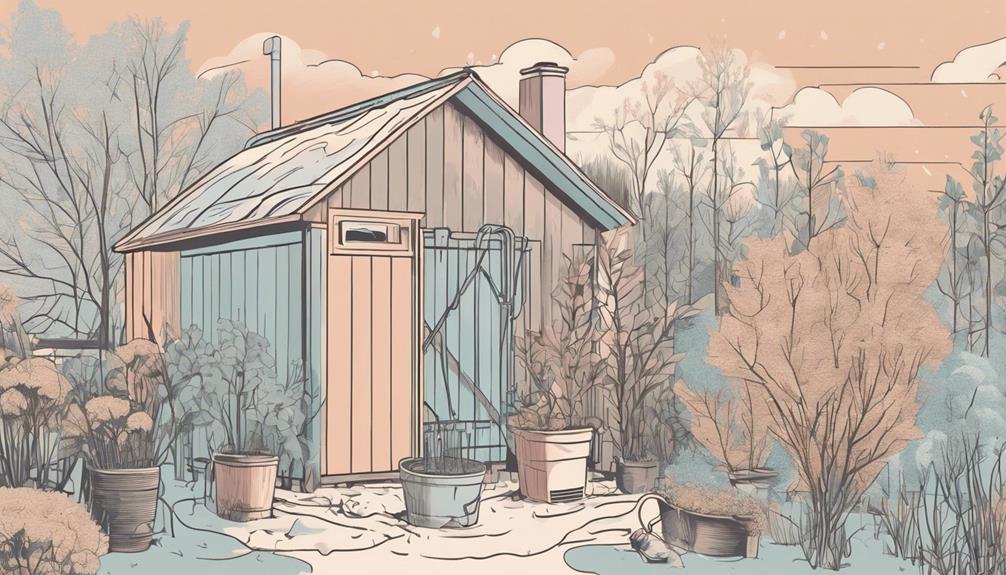How To Become More Self-Sufficient Without Starting a Full-Blown Farm…
Want to start preserving your harvest, making your own soap, or building a backyard root cellar — but not sure where to begin? “Homesteading Advice” gives you instant lifetime access to 35+ practical homesteading books on food preservation, veggie gardening, DIY natural cleaning products (save over $250 per year with this skill alone), brewing, off-grid energy, and a whole lot more…
Click Here To Check It Out Now!
“I recently installed a rainwater harvesting system in my backyard for my small urban farm here in Melbourne. With winter approaching, I’m worried about how the colder temperatures might affect my setup. What steps should I take to winterize the system to ensure it survives and works efficiently when I need it again next spring?” thanks, Ethan, Melbourne, Australia.
How Do I Winterize A Rainwater System?
Getting your rainwater system ready for winter is essential to protecting your investment and ensuring it stays functional for the next season. Here is a comprehensive and user-friendly guide to help you winterize your rainwater system with ease and efficiency.
1. Assessing Your System
Before diving into specific steps, it’s important to understand the components of your system. Most rainwater harvesting systems include:
- Catchment Area: Usually the roof, where rainwater is collected.
- Gutters and Downspouts: Channels that direct water from the catchment area to storage.
- Filters: To remove debris and contaminants.
- Storage Tank: Where the water is stored.
- Pumps and Pipelines: For distributing the stored water to its application points.
Understanding each component helps in addressing what needs attention during winterization.
2. Cleaning Your System
The first step in winterizing any rainwater collection system is a thorough cleaning. Debris and sediment can cause clogs and other issues if left unchecked. Here’s how to clean different parts of your system:
Catchment Area
A good clean roof is essential. Sweep off leaves, branches, and any other debris. Also, inspect for areas where water ponding might occur and clear those zones.
Gutters and Downspouts
Remove leaves, dirt, and other debris from the gutters and downspouts. Use a garden hose to flush out any residues.
Filters
Check and clean all filters. Remove them if they are designed to be taken out in winter to prevent freezing damage.
Storage Tank
Empty and clean the tank to remove any sediment buildup. Use a tank cleaning brush and non-toxic cleaner if necessary.
3. Draining and Disconnecting
Winter temperatures can cause water to freeze and expand, which can lead to cracks and other damage. Here’s how to safely drain and disconnect your system:
Storage Tank Draining
If you live in an area with harsh winters, consider completely draining the storage tank. Leaving water inside can risk freezing and damaging the tank.
Pipeline Draining
Drain all pipelines leading to and from the storage tank. Ensure no water is left that can freeze and cause pipes to burst.
Disconnect Pumps and Accessories
Disconnect and safely store any pumps or accessories to prevent them from freezing and becoming damaged.
4. Protecting and Insulating Components
In regions with severe winters, insulation for the remaining components is critical. Here’s how to go about it:
Insulate Pipelines
Use foam pipe insulation to cover all exposed pipelines. This helps to prevent freezing and safeguard the integrity of the pipes.
Cover the Storage Tank
If your tank is designed to withstand partial water storage and you choose to leave some water inside, add insulation around the tank. A tank cover or blanket can reduce freezing risks.
5. Maintenance Checks
Regular maintenance checks are crucial to ensuring your system remains in good shape throughout the winter. Follow these tips:
- Inspecting Weekly: Check the system weekly for signs of any ice formation or potential damage.
- Monitor Weather: Stay updated on weather conditions and plan proactive measures during extreme cold spells.
- Pest Control: Ensure that rodents or other animals don’t find shelter in your system components.
6. Planning for Thaw
Once winter starts to thaw, reverse the disconnection and insulating steps safely to ensure your system is ready for spring. Steps to take include:
Reattach pumps and ensure they operate correctly. Check pipelines for any damage and replace if necessary. Flush the system with clean water before usage to ensure cleanliness. Inspect all filters and re-attach them if removed.
Final Thoughts…
Ethan, preparing your rainwater harvesting system for winter is a vital task that protects it from damage and ensures it functions correctly when needed again. Thank you for reaching out. Enjoy the peace of mind as your system safely weathers the cold!

